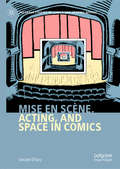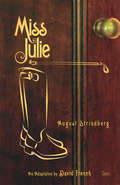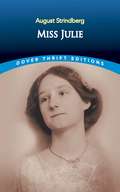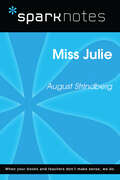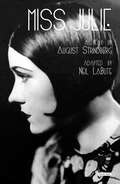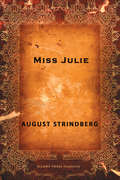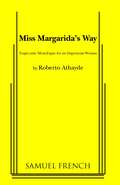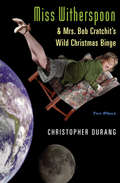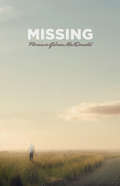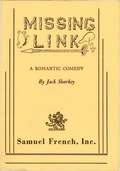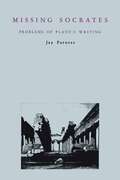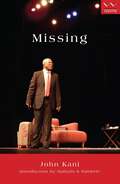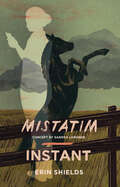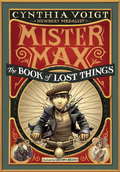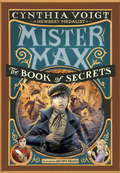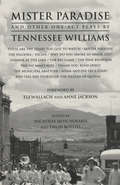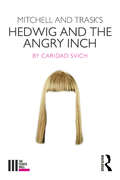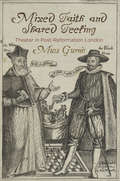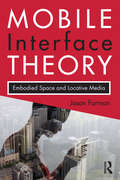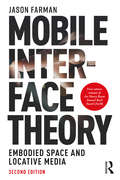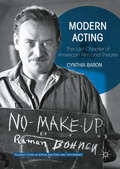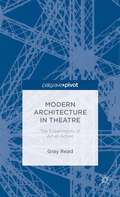- Table View
- List View
Mise en scène, Acting, and Space in Comics (Palgrave Studies in Comics and Graphic Novels)
by Geraint D'ArcyThis book explores some of the less frequently questioned ideas which underpin comics creation and criticism. “Mise en scène” is a term which refers to the way in which visual elements work together to create meaning in comics. It is a term that comics have borrowed from cinema, which borrowed it in turn from theatre. But comics are not film and they are not cinema, so how can this term be of any use? If we consider comics to have mise en scène, should not we also ask if the characters in comics act like the characters on film and stage? In its exploration of these ideas, this book also asks what film and theatre can learn from comics.
Miss Julie
by David French August StrindbergDavid French's adaptation of August Strindberg's disturbing and enduring drama of the transgressive affair between the daughter of a count and the count's man-servant has an eerie contemporary feel about it. French has sharpened the psychodramas of the original - scenes of desire, anger, jealousy, coercion, manipulation, exploitation, arrogance, dominance, submission, and deceit. Cast of 2 women and 1 man.
Miss Julie (Dover Thrift Editions Ser.)
by August StrindbergIn Miss Julie, a willful young aristocrat, whose perverse nature has already driven her fiancé to break off their engagement, pursues and effectively seduces her father's valet during the course of a Midsummer's Eve celebration. The progress of that seduction and the play's stunning denouement shocked Swedish audiences who first attended the play in 1889.Despite its controversial debut, this now-classic drama, inspired by the new ideas of naturalism and psychology that swept Europe in the late 19th century, helped to shape modern theater, and remains one of the most potent-and most frequently performed-of modern plays. The full text of Miss Julie is reprinted here as translated by Edwin Björkman, complete with Strindberg's critical preface to the play, considered by many to be one of the most important manifestos in theater history.
Miss Julie (SparkNotes Literature Guide Series)
by SparkNotesMiss Julie (SparkNotes Literature Guide) by August Strindberg Making the reading experience fun! Created by Harvard students for students everywhere, SparkNotes is a new breed of study guide: smarter, better, faster.Geared to what today's students need to know, SparkNotes provides:*Chapter-by-chapter analysis *Explanations of key themes, motifs, and symbols *A review quiz and essay topicsLively and accessible, these guides are perfect for late-night studying and writing papers
Miss Julie: A Play
by Neil Labute August StrindbergIn his electrifying new adaptation of August Strindberg's Miss Julie, Neil LaBute, provocateur of the theater as much as Strindberg himself, transports the classic play of power, class and seduction to an estate on Long Island's Gold Coast just before the stock market crash of 1929. Against a glittering jazz-age backdrop, mistress of the house Julie and ambitious servant John face off in a gripping, night-long encounter. As the balance of power shifts often and dangerously---sometimes with exquisite subtlety, sometimes stark brutality---LaBute masterfully reinterprets Strindberg's timeless erotic struggle between a man and a woman. This thrilling, essential Miss Julie, which had its world premiere at the Geffen Playhouse in 2013 with Lily Rabe as Julie, Logan Marshall-Green as John, and Laura Heisler as Kristine, superbly embodies both the passionate spirit of the original and the unflinching style of Neil LaBute.
Miss Julie: A Play (Dover Thrift Editions)
by August StrindbergMiss Julie is a naturalistic play written in 1888 by August Strindberg. It is set on Midsummer's Eve on the estate of a count in Sweden. The young woman of the title is drawn to a senior servant, a valet named Jean, who is particularly well-traveled, well-mannered and well-read. The action takes place in the kitchen of Miss Julie's father's manor, where Jean's fiancée, a servant named Christine, cooks and sometimes sleeps while Jean and Miss Julie talk.
Miss Margarida's Way
by Roberto AthaydeBlack Comedy / 1m, 2f / Estelle Parsons created a sensation in New York as the title character, a teacher who runs her classroom with an iron fist, velvet glove not included! Banned, then censored in Brazil, the playwright's homeland, Miss Margarida's Way is a searing drama that looks deeply into the heart of power. Audiences and critics in over 50 countries have cheered this allegory about totalitarianism which uses as its' central metaphor a classroom. Miss Margarida teaches, teases and taunts her eighth grade class through mathematics, geography, history and her own private curriculum. Unbalanced by sexual frustrations she can only express in aggression focused on her students, Miss Margarida is an engaging monster; a dictator with the audience as her student body.
Miss Witherspoon and Mrs. Bob Cratchit's Wild Christmas Binge: Two Plays (Books That Changed the World)
by Christopher DurangFrom one of theater’s most outrageous comic talents, two plays—one a Pulitzer Prize in Drama finalist, the other a twisted take on Christmas classics.In this book, Christopher Durang, the criminally funny author of Sister Mary Ignatius Explains It All for You, presents two plays about death, religion, and a creamy Christmas pudding. In Miss Witherspoon—named one of the Ten Best Plays of 2005 by both Time and Newsday—Veronica, a recent suicide whose cantankerous attitude has not improved in the afterlife, discovers that the one thing worse than the world she left behind is having to go back for seconds. Ordered to cleanse her “brown tweedy aura,” Veronica resists being reincarnated (as a trailer-trash teen or an overexcited Golden Retriever), only to find that she may be mankind’s last, best hope for survival. In Mrs. Bob Cratchit’s Wild Christmas Binge, a sassy ghost once again attempts to shake Scrooge from his holiday humbug, but the whole family-friendly affair is deliciously derailed by Mrs. Cratchit’s drunken insistence on stepping out of her miserable, treacly role. Morals are subverted, starving yet plucky children sing carols, and somebody’s goose is cooked as Durang lovingly skewers A Christmas Carol, It’s a Wonderful Life, and many more to create a brand-new, cracked Christmas classic.
Missing
by Florence Gibson MacdonaldCarol's own marriage is dragged into the spotlight and it seems that everyone is harbouring their own toxic secrets; things are certainly not as they seem. Inspired by a true story, Florence Gibson MacDonald digs at the secrets that hide behind family bonds and examines the complacency and complicitness of community. A story about love, companionship, trust, and loyalty, Gibson MacDonald reveals what can be found when we choose to look at what lurks just below the surface of those we love.
Missing Link
by Jack SharkeyComedy / 4 or 5m, 6f / Interior / Lindy Baxter misses Lincoln Sinclair in fact she's been missing Link since World War II when he vanished in the Pacific. A fall puts her into the hands and the arms of orthopedist Simon Fletcher. They set a wedding date despite her parents misgivings and the fact that the best man and his sister, the maid of honor, are respectively in love with the bride and the groom. On the wedding's eve, Link shows up with an enormous diamond ring and a box of money as his gift for the bride who he thinks is marrying him. A reporter comes with a strange story about another vanished man and Link's mother arrives with a question about an identifying birthmark. Then a cross between an aborigine and a savage shows up and he certainly resembles the missing Link (in more ways than one)! Who's who? What's what? Will have audiences rolling in the aisles.
Missing Socrates: Problems of Plato's Writing (G - Reference, Information and Interdisciplinary Subjects)
by Jay FarnessPlato's conversations of Socrates are among the most accessible philosophical texts most of us have ever read, yet the more one pursues the art or intelligibility of this writing, the more mysterious and paradoxical the Platonic texts become. What does it mean to study Plato, not philosophically as a maker of arguments, not poetically as a maker of dialogues, but literally as a maker of texts? This is a question that Jacques Derrida has made his own, and in this book Farness creates a dialogue with Derrida on Plato's texts.Missing Socrates also provides a dialogue between Plato and Socrates on the question of speech versus writing and a study of the materiality of Plato's writing. Included among the various dialogues and themes developed here are rhetoric and courtroom practice in the Apology of Socrates; religion, skepticism, and the idea of transcendence in the Euthyphro; artistic practice and tradition in the Ion; education and political discipline in the Charmides; and rhetoric, writing, commemoration, and the motives of authorship in Phaedrus. In each of these discursive settings, Socrates unsuccessfully seeks a place or a mode for philosophy; Farness shows that the dialogues of Plato uncannily supply that lack.
Missing: A play
by John KaniMissing is the story of Robert Khalipa, an ANC cadre living in exile, who is very senior in the organisation but is left out of the negotiations and almost forgotten in Sweden. Robert has a wealthy Swedish wife, Anna, and they have a daughter who is a practising doctor in a hospital in Stockholm. There is also Robert’s protégé Peter Tshabalala, junior in the organisation, yet he gets the call to return to South African to join the democratic government. What follows is a story of conspiracies, lies, back stabbing and disappointments. Robert and his family are faced with the challenges of a South Africa that has changed radically from the one he remembers from more than thirty years ago. The government, in his opinion, does not seem to uphold the principles enshrined in the Freedom Charter. There is also conflict within his own family. Robert wants to stay in South Africa, while his wife and daughter want to go back to Sweden. Their love is tested to breaking point and difficult decisions have to be made by every individual. As with Kani’s very successful and often-performed previous play, Nothing but the Truth, the ambiguities of freedom and of personal commitment are explored in this play.
Mistatim / Instant
by Erin ShieldsIn these two plays for young audiences, award-winning playwright Erin Shields presents the challenges of friendship and communication. In Mistatim, which is based on a concept from Sandra Laronde of Red Sky Performance, two eleven-year-olds strike up an unlikely friendship at the fence between one’s reserve and the other’s ranch. On Speck’s side, she’s carved names of family members into the wooden posts as she tries to piece together her identity. On Calvin’s side, he’s trying to train a horse in order to prove himself to his father. When Speck realizes she can communicate with Calvin’s horse Mistatim, the pair work to liberate the animal, and in the process learn about one another’s cultures. In Instant, three teens find out how far they’ll go in their quest to be seen and heard. Meredith is a singer-songwriter who makes YouTube videos of covers in an attempt to gain Internet fame. But her friend Jay, a rising hockey star, can’t understand why she won’t post her original songs. When their classmate Rosie suddenly goes viral after a video is posted of her singing to raise money for her father’s medical bills, Meredith’s jealousy takes over and she pushes Rosie too far, triggering a near-deadly response.
Mister Max: The Book of Lost Things
by Cynthia Voigt Iacopo BrunoMax's parents are missing. They are actors, and thus unpredictable, but sailing away, leaving Max with only a cryptic note, is unusual even for them. Did theyintend to leave him behind? Have they been kidnapped? Until he can figure it out, Max feels it's safer to keep a low profile. Hiding out is no problem for a child of the theater. Max has played many roles, he can be whoever he needs to be to blend in. But finding a job is tricky, no matter what costume he dons.Ironically, it turns out Max has a talent for finding things. He finds a runaway child, a stray dog, a missing heirloom, a lost love. . . . So is he a finder? A detective? No, it's more. Max finds a way to solve people's problems--he engineers better outcomes for them. He becomes Mister Max, Solutioneer. Now if only he could find a solution to his own problems . . .
Mister Max: The Book of Secrets
by Cynthia Voigt Iacopo BrunoFrom Newbery Medalist Cynthia Voigt, Book II in the exciting adventures of Mister Max--12-year-old detective in disguise. In Mister Max: The Book of Lost Things, Max Starling proved that he is more than a detective, he's a Solutioneer. His reputation for problem-solving has been spreading--and now even the mayor wants his help. Someone is breaking windows and setting fires in the old city, but the shopkeepers won't say a word about the culprits. Why are they keeping these thugs' secrets? When the mayor begs for help, Max agrees to take the case, putting himself in grave danger. It's a race to catch up with the vandals before they catch him. Meanwhile, Max is protecting secrets of his own. His parents are still missing, and the cryptic messages he gets from them make it clear--it's going to be up to Max to rescue them. Can the Solutioneer handle cases this big?
Mister Paradise and Other One-Act Plays
by Anne Jackson Eli Wallach Tennessee Williams David E. Roessel Nicholas Rand MoschovakisThirteen previously unpublished short plays now available for the first time. Tennessee Williams had a distinct talent for writing short plays and, not surprisingly, this remarkable new collection of never-before-published one-acts includes some of his most poignant and hilarious characters: the indefatigable, witty and tough drag queens of And Tell Sad Stories of the Deaths of Queens...; the strange little man behind the nom de plume Mister Paradise; and the extravagant mistress who cheats on her married man in The Pink Bedroom. Most were written in the 1930s and early 1940s when Williams was already flexing his theatrical imagination. Chosen from over seventy unpublished one-acts, these are some of Williams's finest; several have premiered recently at The Hartford Stage Co., The Kennedy Center, the Manhattan Theatre Club and the Tennessee Williams/New Orleans Literary Festival. Included in this volume: These Are the Stairs You Got to Watch Mister Paradise The Palooka Escape Why Do You Smoke So Much, Lily? Summer At the Lake The Big Game The Pink Bedroom The Fat Man's Wife Thank You, Kind Spirit The Municipal Abattoir Adam and Eve on a Ferry And Tell Sad Stories of the Deaths of Queens... Long associated with Williams, acclaimed stage and film actors Eli Wallach and Anne Jackson provide a fresh and challenging foreword for actors, directors, and readers.
Mitchell and Trask's Hedwig and the Angry Inch (The Fourth Wall)
by Caridad Svich'… love creates something that was not there before.' – Hedwig John Cameron Mitchell and Stephen Trask’s Hedwig and the Angry Inch opened on Valentine’s Day,1998, in New York City, and ever since, it and its genderqueer heroine have captivated audiences around the world. As the first musical to feature a genderqueer protagonist as its lead, the show has had an extraordinary life on film, Broadway and in the music field. A glam rock musical with a complex relationship to issues related to art, eroticism and matters of identity formation, Hedwig and the Angry Inch is a darkly exuberant fairy tale about a child that discovers she is one of a kind, but also potentially among her own kind, if she dares travel past borders that confine and try to stabilise her being and identity. Caridad Svich examines this exhilarating work through the lenses of visual and vocal rock ’n’ roll performance, the history of the American musical, and its positioning within LGBTIQ+ theatre.
Mixed Faith and Shared Feeling: Theater in Post-Reformation London
by Musa GurnisMixed Faith and Shared Feeling explores the mutually generative relationship between post-Reformation religious life and London's commercial theaters. It explores the dynamic exchange between the imaginatively transformative capacities of shared theatrical experience, with the particular ideological baggage that individual playgoers bring into the theater. While early modern English drama was shaped by the polyvocal, confessional scene in which it was embedded, Musa Gurnis contends that theater does not simply reflect culture but shapes it. According to Gurnis, shared theatrical experience allowed mixed-faith audiences to vicariously occupy alternative emotional and cognitive perspectives across the confessional spectrum.In looking at individual plays, such as Thomas Middleton's A Game of Chess and Shakespeare's Measure for Measure, Gurnis shows how theatrical process can restructure playgoers' experiences of confessional material and interrupt dominant habits of religious thought. She refutes any assumption that audiences consisted of conforming Church of England Protestants by tracking the complex and changing religious lives of seventy known playgoers. Arguing against work that seeks to draw fixed lines of religious affiliation around individual playwrights or companies, she highlights the common practice of cross-confessional collaboration among playhouse colleagues. Mixed Faith and Shared Feeling demonstrates how post-Reformation representational practices actively reshaped the ways ideologically diverse Londoners accessed the mixture of religious life across the spectrum of beliefs.
Mobile Interface Theory: Embodied Space and Locative Media
by Jason FarmanMobile media – from mobile phones to smartphones to netbooks – are transforming our daily lives. We communicate, we locate, we network, we play, and much more using our mobile devices. In Mobile Interface Theory, Jason Farman demonstrates how the worldwide adoption of mobile technologies is causing a reexamination of the core ideas about what it means to live our everyday lives. He argues that mobile media’s pervasive computing model, which allows users to connect and interact with the internet while moving across a wide variety of locations, has produced a new sense of self among users – a new embodied identity that stems from virtual space and material space regularly enhancing, cooperating or disrupting each other. Exploring a range of mobile media practices – including mobile maps and GPS technologies, location-aware social networks, urban and alternate reality games that use mobile devices, performance art, and storytelling projects – Farman illustrates how mobile technologies are changing the ways we produce lived, embodied spaces.
Mobile Interface Theory: Embodied Space and Locative Media
by Jason FarmanIn this updated second edition, Jason Farman offers a groundbreaking look at how location-aware mobile technologies are radically shifting our sense of identity, community, and place-making practices. Mobile Interface Theory is a foundational book in mobile media studies, with the first edition winning the Book of the Year Award from the Association of Internet Researchers. It explores a range of mobile media practices from interface design to maps, AR/VR, mobile games, performances that use mobile devices, and mobile storytelling projects. Throughout, Farman provides readers with a rich theoretical framework to understand the ever-transforming landscape of mobile media and how they shape our bodily practices in the spaces we move through. This fully updated second edition features updated examples throughout, reflecting the shifts in mobile technology. This is the ideal text for those studying mobile media, social media, digital media, and mobile storytelling.
Modern Acting
by Cynthia BaronEveryone has heard of Method acting . . . but what about Modern acting? This book makes the simple but radical proposal that we acknowledge the Modern acting principles that continue to guide actors' work in the twenty-first century. Developments in modern drama and new stagecraft led Modern acting strategies to coalesce by the 1930s - and Hollywood's new role as America's primary performing arts provider ensured these techniques circulated widely as the migration of Broadway talent and the demands of sound cinema created a rich exchange of ideas among actors. Decades after Strasberg's death in 1982, he and his Method are still famous, while accounts of American acting tend to overlook the contributions of Modern acting teachers such as Josephine Dillon, Charles Jehlinger, and Sophie Rosenstein. Baron's examination of acting manuals, workshop notes, and oral histories illustrates the shared vision of Modern acting that connects these little-known teachers to the landmark work of Stanislavsky. It reveals that Stella Adler, long associated with the Method, is best understood as a Modern acting teacher and that Modern acting, not Method, might be seen as central to American performing arts if the Actors' Lab in Hollywood (1941-1950) had survived the Cold War.
Modern American Drama on Screen
by William Robert Bray R. Barton PalmerFrom its beginnings, the American film industry has profited from bringing popular and acclaimed dramatic works to the screen. This is the first book to offer a comprehensive account, focusing on key texts, of how Hollywood has given a second and enduring life to such classics of the American theater as Long Day's Journey into Night, A Streetcar Named Desire and Who's Afraid of Virginia Woolf? Each chapter is written by a leading scholar and focuses on Broadway's most admired and popular productions. The book is ideally suited for classroom use and offers an otherwise unavailable introduction to a subject which is of great interest to students and scholars alike.
Modern Architecture in Theater: The Experiments of Art et Action
by Gray ReadIf the city is the theatre of urban life, how does architecture act in its many performances? This book reconstructs the spatial experiments of Art et Action, a theatre troupe active in 1920s Paris, and how their designs for theater buildings show how the performance spaces interacted with actors and spectators according to their type.
Modern British Drama on Screen
by William Robert Bray R. Barton PalmerThis collection of essays offers the first comprehensive treatment of British and American films adapted from modern British plays. Offering insights into the mutually profitable relationship between the newest performance medium and the most ancient. With each chapter written by an expert in the field, Modern British Drama on Screen focuses on key playwrights of the period including George Bernard Shaw, Somerset Maugham, Terence Rattigan, Noel Coward and John Osborne and the most significant British drama of the past century from Pygmalion to The Madness of George III. Most chapters are devoted to single plays and the transformations they underwent in the move from stage to screen. Ideally suited for classroom use, this book offers a semester's worth of introductory material for the study of theater and film in modern Britain, widely acknowledged as a world center of dramatic productions for both the stage and screen.

